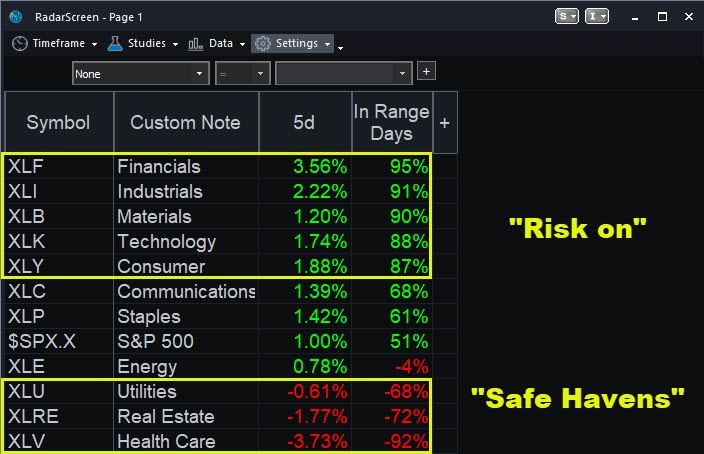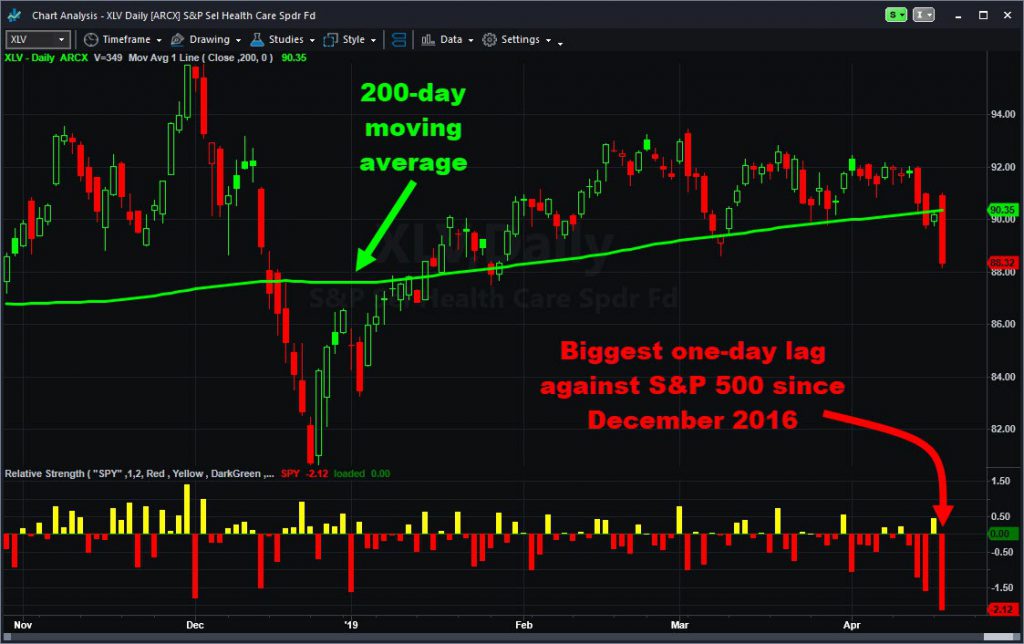Health care stocks got slammed yesterday amid an apparent rotation away from “safe havens.”
The SPDR Health Care ETF (XLV) dropped 2.05 percent to its lowest price since January 30. While not that might not sound huge, it was the biggest drop relative to the broader market in more than two years.
Other “safe havens” like utilities (XLU) and real-estate investment trusts (XLRE) also took a beating. Notice on the RadarScreen® below they’ve lagged in the last week and are near the bottom of their five-session price ranges.

What’s going on? It’s not entirely clear, but a perfect storm of bearish factors seem to be coming together.
First, interest rates are shooting higher after testing their lowest levels in about a year. Remember they fell so much after Jerome Powell’s Federal Reserve took a sharp dovish turn in January and February. Now they’re reverting to their previous areas.
Second, the market seems to be looking for a stronger economy. Did you know the Atlanta Fed has revised its first-quarter economic growth forecast from under 0.5 percent to over 2 percent in barely a month? Did you also know initial jobless claims fell below 200,000 last week for the first time since late 1969? Maybe that’s why railroads already broke out to new highs.
Third, attention is shifting away from geopolitical risk. Europe has kicked the Brexit can down the road once again, while President Trump seems to have softened his tone toward China. That’s letting investors focus on companies’ first-quarter earnings reports.
Health Care Sickly
Fourth, negativity keeps mounting toward health-care companies. Members of the XLV accounted for the five biggest decliners in the S&P 500 on Tuesday. In fact, only six of the portfolio’s 63 members managed to rise in the session.
Again, the reasons weren’t clear, but there’s been a clear trend toward price cuts. Cigna (CI), for example, limited insulin prices on April 3. Walgreen Boots Alliance (WBA) cratered on weak pricing the previous day.

Last month, dialysis company DaVita (DVA) fell after the government moved to lower its reimbursements and insurance giant UnitedHealth (UNH) said it would pass on lower prices to consumers. That’s all bad for margins.
Take a step back to consider the bigger picture. For years, health-care companies were able to raise prices faster than the general rate of inflation. But now that trend is showing signs of running its course — especially as both political parties turn against the industry.
Risk-On Sectors Rally
The drop in safe-havens is especially interesting when compared with “risk-on” sectors like financials and industrials. Those tend to benefit from a stronger economy and higher interest rates. Does Tuesday’s stark divergence between the “safe-haven” and “risk-on” camps reflect deeper bullishness in the market?
Larry Fink, CEO of mutual-fund giant Blackrock (BLK) thinks so. Yesterday he warned of a potential “melt-up” as skittish money managers are forced to rush out of cash and into equities.
Almost in tandem, a Bank of America Merrill Lynch survey revealed investor bearishness had just reached a three-year high. (It looks like they missed the historically positive “golden cross” pattern in the S&P 500 earlier this month.)
In conclusion, the S&P 500 barely moved on Tuesday. But there was plenty of excitement beneath the surface as investors seemed to shift from a cautious attitude back toward risk appetite.




























